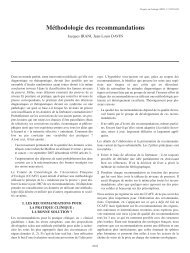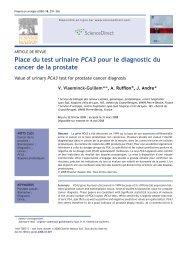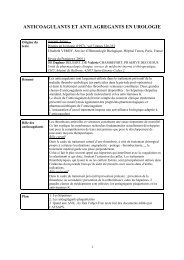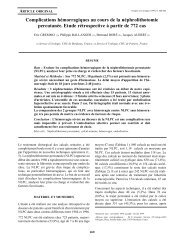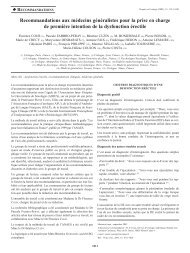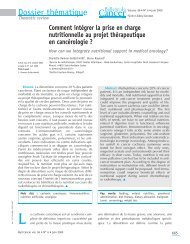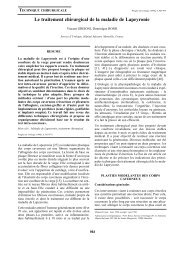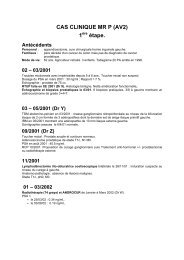Multi-Detector row CT urography on a 16-row CT scanner in the ...
Multi-Detector row CT urography on a 16-row CT scanner in the ...
Multi-Detector row CT urography on a 16-row CT scanner in the ...
Create successful ePaper yourself
Turn your PDF publications into a flip-book with our unique Google optimized e-Paper software.
is small, we successfully detected seven (100%) of seven<br />
foci of upper tract malignancies and n<strong>in</strong>e (90%) of 10<br />
ur<strong>in</strong>ary bladder malignancies, <strong>in</strong>clud<strong>in</strong>g seven tumors with<br />
a diameter equal or smaller than 0.5 cm. MD<str<strong>on</strong>g>CT</str<strong>on</strong>g>U has<br />
dem<strong>on</strong>strated satisfactory results <strong>in</strong> <strong>the</strong> detecti<strong>on</strong> of<br />
uroepi<strong>the</strong>lial malignancies [5, 13, 15, 25]. Caoili et al. [5]<br />
detected 15 out of <strong>16</strong> foci of TCCs, <strong>in</strong>clud<strong>in</strong>g <strong>on</strong>e lesi<strong>on</strong> of<br />
5 mm <strong>in</strong> maximal diameter. The same group of<br />
<strong>in</strong>vestigators [15] retrospectively review<strong>in</strong>g 370 MD<str<strong>on</strong>g>CT</str<strong>on</strong>g><br />
<str<strong>on</strong>g>urography</str<strong>on</strong>g> exam<strong>in</strong>ati<strong>on</strong>s of patients suspected of ur<strong>in</strong>ary<br />
tract disease, identified 24 of 27 upper tract cancers,<br />
<strong>in</strong>clud<strong>in</strong>g five masses with a diameter equal or smaller than<br />
5 mm. In ano<strong>the</strong>r series, McCarthy and Cowan [25]<br />
perform<strong>in</strong>g MD<str<strong>on</strong>g>CT</str<strong>on</strong>g>U and retrograde pyelography <strong>in</strong> 106<br />
high-risk patients correctly identified all upper tract<br />
malignancies, with MD<str<strong>on</strong>g>CT</str<strong>on</strong>g>U prov<strong>in</strong>g more sensitive than<br />
retrograde pyelography (sensitivity: 98% versus 79%). In<br />
<strong>the</strong> same study <strong>on</strong>ly <strong>on</strong>e bladder cancer was not detected.<br />
In ano<strong>the</strong>r multi-<strong>in</strong>stituti<strong>on</strong>al study [13] of 350 patients<br />
with hematuria four patients had bladder TCCs, <strong>on</strong>e had an<br />
urachal adenocarc<strong>in</strong>oma and <strong>on</strong>ly <strong>on</strong>e patient had TCC of<br />
<strong>the</strong> upper tact, all detected <strong>on</strong> MD<str<strong>on</strong>g>CT</str<strong>on</strong>g>U. The above groups<br />
of <strong>in</strong>vestigators used ei<strong>the</strong>r a 4- or an 8-detector <str<strong>on</strong>g>row</str<strong>on</strong>g> <str<strong>on</strong>g>CT</str<strong>on</strong>g><br />
<strong>scanner</strong>. Our study dem<strong>on</strong>strated that <strong>16</strong>-<str<strong>on</strong>g>row</str<strong>on</strong>g> <str<strong>on</strong>g>CT</str<strong>on</strong>g> <str<strong>on</strong>g>urography</str<strong>on</strong>g><br />
could detect uroepi<strong>the</strong>lial malignancies, <strong>in</strong>clud<strong>in</strong>g<br />
lesi<strong>on</strong>s of small size, even though a larger number of<br />
patients are needed to support <strong>the</strong> above data. The<br />
satisfactory results of <strong>16</strong>-<str<strong>on</strong>g>row</str<strong>on</strong>g> <str<strong>on</strong>g>CT</str<strong>on</strong>g> <str<strong>on</strong>g>urography</str<strong>on</strong>g> <strong>in</strong> <strong>the</strong><br />
detecti<strong>on</strong> of ur<strong>in</strong>ary bladder neoplasms <strong>in</strong> this study,<br />
perhaps <strong>the</strong>y would obviate <strong>the</strong> need of perform<strong>in</strong>g<br />
c<strong>on</strong>venti<strong>on</strong>al cystoscopy <strong>in</strong> patients present<strong>in</strong>g with hematuria<br />
and positive results <strong>on</strong> MD<str<strong>on</strong>g>CT</str<strong>on</strong>g> <str<strong>on</strong>g>urography</str<strong>on</strong>g>.<br />
Of major c<strong>on</strong>cern with <str<strong>on</strong>g>CT</str<strong>on</strong>g> <str<strong>on</strong>g>urography</str<strong>on</strong>g>, as well as with<br />
IVU, is <strong>the</strong> necessity for complete distenti<strong>on</strong> and opacificati<strong>on</strong><br />
of <strong>the</strong> renal collect<strong>in</strong>g systems and ureters. There is<br />
always a <strong>the</strong>oretical possibility that small uro<strong>the</strong>lial lesi<strong>on</strong>s<br />
located <strong>in</strong> <strong>the</strong>se unopacified segments could be missed.<br />
O<strong>the</strong>r <strong>in</strong>vestigators, however, believe that <strong>the</strong> necessity for<br />
ureteral distenti<strong>on</strong> is simply a radiological myth and that<br />
uro<strong>the</strong>lial neoplasms are manifested at imag<strong>in</strong>g as fill<strong>in</strong>g<br />
defects or obstructi<strong>on</strong> and not as underfill<strong>in</strong>g of <strong>the</strong> uretes<br />
[4]. Even <strong>in</strong> cases of n<strong>on</strong>-complete distenti<strong>on</strong> and opacificati<strong>on</strong><br />
of <strong>the</strong> uretes <strong>the</strong> evaluati<strong>on</strong> of <strong>the</strong> unopacified<br />
segments <strong>on</strong> axial images may be satisfactory [3]. The high<br />
negative predictive value (100%) of <strong>the</strong> n<strong>on</strong>-opacified<br />
ureter for <strong>the</strong> presence of uroepi<strong>the</strong>lial malignancies, as<br />
showed <strong>in</strong> this study, perhaps justifies <strong>the</strong> above statement.<br />
As with o<strong>the</strong>r multiphasic abdom<strong>in</strong>al <str<strong>on</strong>g>CT</str<strong>on</strong>g> protocols, <str<strong>on</strong>g>CT</str<strong>on</strong>g><br />
<str<strong>on</strong>g>urography</str<strong>on</strong>g> exposes <strong>the</strong> patient to <strong>in</strong>creased radiati<strong>on</strong><br />
exposure, which has to be weighted aga<strong>in</strong>st <strong>the</strong> expected<br />
benefit from <strong>the</strong> exam<strong>in</strong>ati<strong>on</strong>. We estimated an effective<br />
dose of 29 mSv is required for our entire protocol<br />
(11.1 mSv for <strong>the</strong> unenhanced scan, 5.9 mSv for <strong>the</strong><br />
nephrographic phase, 11.3 mSv for <strong>the</strong> excretory phase and<br />
1 mSv for PSPR). This value is with<strong>in</strong> <strong>the</strong> range of 25–<br />
35 mSv for an average size male, given by Caoili et al. [5],<br />
for a four-phase protocol, <strong>on</strong> a 4-detector <str<strong>on</strong>g>row</str<strong>on</strong>g> <str<strong>on</strong>g>CT</str<strong>on</strong>g> <strong>scanner</strong>.<br />
The same group of <strong>in</strong>vestigators found that MD<str<strong>on</strong>g>CT</str<strong>on</strong>g>U<br />
exposure for <strong>the</strong> same protocol was similar to <strong>the</strong> radiati<strong>on</strong><br />
exposure result<strong>in</strong>g from <strong>the</strong> comb<strong>in</strong>ati<strong>on</strong> of IVU and<br />
c<strong>on</strong>venti<strong>on</strong>al s<strong>in</strong>gle-phase <str<strong>on</strong>g>CT</str<strong>on</strong>g> exam<strong>in</strong>ati<strong>on</strong>. McTavish et al.<br />
[26] reported a total effective dose of 22.6 mGy, us<strong>in</strong>g a<br />
three-phase protocol, <strong>on</strong> a 4-detector <str<strong>on</strong>g>row</str<strong>on</strong>g> <str<strong>on</strong>g>CT</str<strong>on</strong>g> <strong>scanner</strong>. Sk<strong>in</strong><br />
dose should be also taken <strong>in</strong>to account. In <strong>the</strong> present study<br />
<strong>the</strong> mean sk<strong>in</strong> dose of 58 mGy was similar to <strong>the</strong> 54.6 mGy<br />
mean dose reported by Nawfel et al. [27] and lower than<br />
that of 74.1 mGy reported by McTavish et al. [26].<br />
In c<strong>on</strong>clusi<strong>on</strong>, multidetector <str<strong>on</strong>g>row</str<strong>on</strong>g> <str<strong>on</strong>g>CT</str<strong>on</strong>g> <str<strong>on</strong>g>urography</str<strong>on</strong>g> <strong>on</strong> a <strong>16</strong>-<br />
<str<strong>on</strong>g>row</str<strong>on</strong>g> <str<strong>on</strong>g>CT</str<strong>on</strong>g> <strong>scanner</strong> dem<strong>on</strong>strated satisfactory results <strong>in</strong> <strong>the</strong><br />
<strong>in</strong>vestigati<strong>on</strong> of pa<strong>in</strong>less hematuria, be<strong>in</strong>g able to dem<strong>on</strong>strate<br />
a wide spectrum of diseases affect<strong>in</strong>g <strong>the</strong> ur<strong>in</strong>ary<br />
tract. An important advantage of <strong>the</strong> technique was its<br />
ability to detect uroepi<strong>the</strong>lial malignancies, although a<br />
larger series is needed to c<strong>on</strong>firm <strong>the</strong> effectiveness of <strong>16</strong>-<br />
<str<strong>on</strong>g>row</str<strong>on</strong>g> <str<strong>on</strong>g>CT</str<strong>on</strong>g>U <strong>in</strong> <strong>the</strong> detecti<strong>on</strong> of small-sized tumors.<br />
References<br />
1. Noroozian M, Cohan RH, Caoli EM,<br />
Cowan NC, Ellis JH (2004) <str<strong>on</strong>g>Multi</str<strong>on</strong>g>slice<br />
<str<strong>on</strong>g>CT</str<strong>on</strong>g> <str<strong>on</strong>g>urography</str<strong>on</strong>g>: state of <strong>the</strong> art. Br J Rad<br />
77:S74–S86<br />
2. Kawashima A, Vrtiska TJ, Hartman RP,<br />
McCollough CH, K<strong>in</strong>g BF (2004) <str<strong>on</strong>g>CT</str<strong>on</strong>g><br />
<str<strong>on</strong>g>urography</str<strong>on</strong>g>. Radiographics 24:S35–S54<br />
3. Joffe SA, Servaes S, Ok<strong>on</strong> S, Ho<str<strong>on</strong>g>row</str<strong>on</strong>g>itz<br />
M (2003) <str<strong>on</strong>g>Multi</str<strong>on</strong>g>-detector <str<strong>on</strong>g>row</str<strong>on</strong>g> <str<strong>on</strong>g>CT</str<strong>on</strong>g> <str<strong>on</strong>g>urography</str<strong>on</strong>g><br />
<strong>in</strong> <strong>the</strong> evaluati<strong>on</strong> of hematuria.<br />
Radiographics 23:1441–1455<br />
4. Coakley FV, Yeh BM (2003) Invited<br />
commentary. Radiographics 23:1455–<br />
1456<br />
5. Caoli EM, Cohan RH, Korobk<strong>in</strong> M,<br />
Platt J, Francis I, Faerber G, M<strong>on</strong>tie J,<br />
Ellis J (2002) Ur<strong>in</strong>ary tract abnormalities:<br />
<strong>in</strong>itial experience with multi-detector<br />
<str<strong>on</strong>g>row</str<strong>on</strong>g> <str<strong>on</strong>g>CT</str<strong>on</strong>g> <str<strong>on</strong>g>urography</str<strong>on</strong>g>. Radiology<br />
222:353–360<br />
6. Smith RC, Rosenfield AT, Choe KA,<br />
Essenmacher KR, Verga M, Clickman<br />
MG, Lange RC (1995) Acute flank<br />
pa<strong>in</strong>: comparis<strong>on</strong> of n<strong>on</strong>-c<strong>on</strong>trast enhanced<br />
<str<strong>on</strong>g>CT</str<strong>on</strong>g> and <strong>in</strong>travenous <str<strong>on</strong>g>urography</str<strong>on</strong>g>.<br />
Radiology 194:789–794<br />
7. Wang LJ, Ng CJ, Chen JC, Chiu TF,<br />
W<strong>on</strong>g YC (2004). Diagnosis of acute<br />
flank a<strong>in</strong> caused by ureteral st<strong>on</strong>es:<br />
value of comb<strong>in</strong>ed direct and <strong>in</strong>direct<br />
signs <strong>on</strong> IVU and unenhanced helical<br />
<str<strong>on</strong>g>CT</str<strong>on</strong>g>. Eur Rad 14:<strong>16</strong>34–<strong>16</strong>40<br />
8. Sheth S, Scatarige JC, Hort<strong>on</strong> KM,<br />
Corl FM, Fishman EK (2001) Current<br />
c<strong>on</strong>cepts <strong>in</strong> <strong>the</strong> diagnosis and management<br />
of renal cell carc<strong>in</strong>oma: role of<br />
multidetector <str<strong>on</strong>g>CT</str<strong>on</strong>g> and three-dimensi<strong>on</strong>al<br />
<str<strong>on</strong>g>CT</str<strong>on</strong>g>. Radiographics 21:S237–S254




